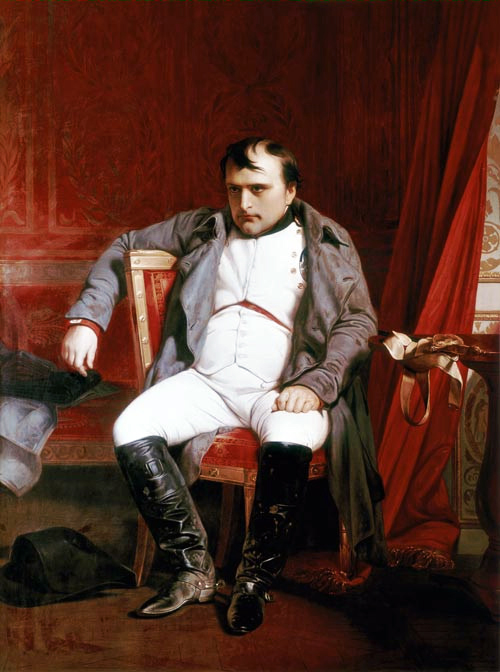Author branding: 3 lessons from Napoleon
/Part 6 in a series on personal branding

For using personal branding to advantage, Napoleon Bonaparte was truly the emperor among history's royals. In Getty Museum's book, Symbols of Power in Art, Napoleon gets his own chapter, "A Case Apart." Historian Jules Tulard wrote, "There have been more works written about Napoleon Bonaparte than there have been days since his death."
His mother said Napoleon behaved like a ruler even from an early age (sounds like a typical toddler to me…) but struggled to fit in at school. He spent a lot of time alone reading, thinking and dreaming. At age 16 he wrote, "Always alone in the midst of people, I return home in order to give myself up with unspeakable melancholy to my dreams. How do I regard life today?"
His dreams even then must have been quite powerful for, while he valued revolution and political reform, what he wanted most was personal glory. His path to power was through military leadership and successes, and he once advised one of his generals to concentrate on "strength, activity, and a firm resolve to die with glory. These are the three great principles of military art which have always turned fortune favourable to me in all my operations. Death is nothing; but to live defeated and without glory is to die every day."
Tulard regarded Napoleon's brand persona as "the myth of the savior," truly the great leader on the white horse, bringing power, prestige and glory to France. Napoleon had a brilliant understanding for how to maintain this image using portraits, objects and writings:
"From carefully falsified army bulletins, to paintings and engravings, to the jewelled snuffboxes adorned with his portrait and distributed to the bishops who officiated at his coronation as Emperor, Napoleon knew how to create a cult of personality that maximised his popularity and sought to win the loyalty of those who might oppose him." --From History Today, "Napoleon the Man," Gemma Betros
His portraits are carefully constructed to show him as a fierce and valiant military leader on the white horse, a thoughtful and compassionate government administrator, a god-like ruler with the scepter of Charles V and the hand of justice of Charlemagne. Eagles on carpets and furniture symbolize imperial power, the bee embroidered into clothing symbolize industry. His feet do not touch the ground but rest on ornate pillows, indicating his godlike authority. In these images he invested heavily, but he could not tolerate criticism and worked to suppress images that opposed this persona.
"When he rose to power in 1799, Napoleon Bonaparte had serious concerns about comedic references to his personage. He immediately ordered the closure of all satirical papers in Paris and let it be known that cartoonists who toyed with his image would be dealt with severely. In 1802, he attempted to insert a clause into the Treaty of Amiens with England stipulating that any British cartoonists or caricaturists who used his image in their art should be treated in the manner of murderers and forgers. The English rejected the unusual amendment." --From psychologist Nichole Force in a post about the dangers of humor
But over time his ability to suppress negative information was unsuccessful, especially when military defeats and other issues began to fray his persona and reveal the divergence between the image and the man. A series of key portraits depict his rise as a young officer and his eventual and dramatic decline, brought on, according to some historians, by his swollen ego and perhaps the remnants of the lonely teenager he had once been.
"Where the eager young officer would energetically mine others for advice, and the self-assured First Consul could openly admit to being wrong, as Emperor Napoleon became increasingly reluctant to hear the opinions of advisors, gradually preferring to work long hours in a solitude that suggested not so much ambition as quiet desperation as he led France to defeat." --Betros
Three takeaways from Napoleon
How can Napoleon's personal branding experience inform the personal branding of an author?
- A personal brand persona must align with the actions of the person. You've heard the old saying, actions speak louder than words. When what you exhibit or say differs from what you actually do, you break down the trust that is essential to any brand, personal or corporate.
- Prepare your brand for transparency rather than duplicity. In Napoleon's day duplicity served him by allowing him to appear to be doing one activity while covertly planning something entirely different. But in today's world of social media, this kind of misrepresentation is almost impossible to maintain and in the long run will get you smeared.
- Always be willing to listen to trusted advisors and well-intended feedback. Just as every writer needs an editor, every person needs to understand how he or she is seen from the outside. Nor can we see all perspectives in every situation. Most people want you to succeed, and their well-intended advice may not always be helpful but it is worth listening to, just in case. It can also help you to temper those things that drive you, so that they do not drive you into the ground.
Next week, Part 7 in the series will look at two American leaders who, although they were not royalty, created strong personas to help them gain the support of the populace.
Previous posts in the series:
Part 1, Intro Part 2, Hatshepsut Part 3, Henry VIII
Part 4, Elizabeth I Part 5, Louis XIV
 Embark on an adventure in Irish history with the novel Sharavogue, winner of the 2014 Royal Palm Literary Award. Now available from online booksellers. Author Nancy Blanton will be presenting at the Amelia Island Book Festival, February 20-21, 2015. You may also connect with her on Facebook.
Embark on an adventure in Irish history with the novel Sharavogue, winner of the 2014 Royal Palm Literary Award. Now available from online booksellers. Author Nancy Blanton will be presenting at the Amelia Island Book Festival, February 20-21, 2015. You may also connect with her on Facebook.





